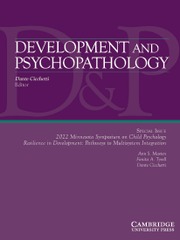Article contents
Longitudinal examination of pathways to peer problems in middle childhood: A siblings-reared-apart design
Published online by Cambridge University Press: 23 August 2019
Abstract
To advance research from Dishion and others on associations between parenting and peer problems across childhood, we used a sample of 177 sibling pairs reared apart since birth (because of adoption of one of the siblings) to examine associations between parental hostility and children's peer problems when children were ages 7 and 9.5 years (n = 329 children). We extended conventional cross-lagged parent–peer models by incorporating child inhibitory control as an additional predictor and examining genetic contributions via birth mother psychopathology. Path models indicated a cross-lagged association from parental hostility to later peer problems. When child inhibitory control was included, birth mother internalizing symptoms were associated with poorer child inhibitory control, which was associated with more parental hostility and peer problems. The cross-lagged paths from parental hostility to peer problems were no longer significant in the full model. Multigroup analyses revealed that the path from birth mother internalizing symptoms to child inhibitory control was significantly higher for birth parent–reared children, indicating the possible contribution of passive gene–environment correlation to this association. Exploratory analyses suggested that each child's unique rearing context contributed to his or her inhibitory control and peer behavior. Implications for the development of evidence-based interventions are discussed.
Information
- Type
- Special Issue Articles
- Information
- Development and Psychopathology , Volume 31 , Special Issue 5: Honoring the Contributions and Legacy of Thomas Dishion , December 2019 , pp. 1633 - 1647
- Copyright
- Copyright © Cambridge University Press 2019
References
- 8
- Cited by

